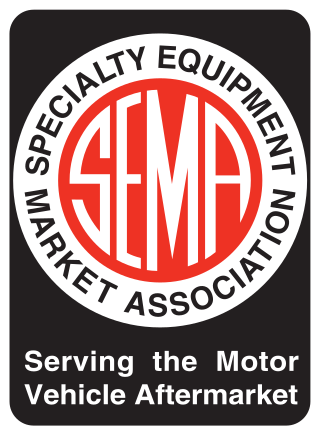
A muscle car is an American-made two-door sports coupe with a powerful engine, generally designed for high-performance driving.

The Detroit Auto Show, formerly known as the North American International Auto Show (NAIAS), is an annual auto show held in Detroit, Michigan. Hosted at Huntington Place since 1965, it is among the largest auto shows in North America, and is widely regarded as one of the automotive industry's most important events.

In the automotive industry, rebadging is a form of market segmentation used by automobile manufacturers around the world. To allow for product differentiation without designing or engineering a new model or brand, a manufacturer creates a distinct automobile by applying a new "badge" or trademark to an existing product line.

The tailfin era of automobile styling encompassed the 1950s and 1960s, peaking between 1955 and 1961. It was a style that spread worldwide, as car designers picked up styling trends from the US automobile industry, where it was regarded as the "golden age" of American auto design and American exceptionalism.

The B platform is a full-size, rear-wheel drive, body-on-frame car platform, that was produced by General Motors (GM) from 1926 to 1996. Originally made for Oldsmobile and Buick, all of General Motors's five main passenger car makes would use it at some point. It was closely related to the original rear-wheel drive C and D platforms, and was used for convertibles, hardtops, coupes, sedans, and station wagons. With approximately 12,960,000 units built, divided across four marques, the 1965–1970 B platform is the fourth best selling automobile platform in history after the Volkswagen Beetle, Ford Model T, and the Fiat 124.
Arlington Assembly is a General Motors automobile factory located in Arlington, Texas. The plant has operated for more than 60 years and today manufactures large SUVs from GM's divisions Chevrolet, GMC and Cadillac.

Specialty Equipment Market Association (SEMA) of the automotive aftermarket was formed in 1963 by Paul Schiefer, Roy Richter, Ed Iskenderian, Els Lohn, Willie Garner, Bob Hedman, Robert E. Wyman, John Bartlett, Phil Weiand Jr, Al Segal, Dean Moon, and Vic Edelbrock Jr. Now it consists of 6,383 companies worldwide, bringing together aftermarket manufacturers, original equipment manufacturers (OEM), media, car dealers, specialty equipment distributors, installers, retailers, and restoration specialists.
Linden Assembly was a General Motors automobile factory in Linden, New Jersey, United States. The plant operated from 1937 to 2005 and made cars, trucks and SUVs for various GM automotive divisions.

The Los Angeles Auto Show, also known as the LA Auto Show, is an auto show held annually at the Los Angeles Convention Center in Los Angeles, California, United States. It is open to the public for ten days, filling 760,000 square feet (71,000 m2) of exhibit space. Since 2006 the event is held in November or December.
The GM A platform was a rear wheel drive automobile platform designation used by General Motors from 1925 until 1959, and again from 1964 to 1981. In 1982, GM introduced a new front wheel drive A platform, and existing intermediate rear wheel drive products were redesignated as G-bodies.
American Muscle Car is a weekly television show on Speed, produced by Restoration Productions LLC., about muscle cars. Original release was in 2003. Each episode provides a timeline of each vehicle's history beginning with its first year of production to its most recent year of production. The show was initially designed to showcase traditional muscle cars such as the Chevrolet Camaro, Ford Mustang, and Dodge Charger. It eventually added other performance vehicles such as the Shelby Cobra and the, and even began to focus on specific eras such as the (disambiguation)|. In 2006 season, the show's focus was expanded to include designers and engineers of muscle car era.
In the context of the automobile industry, downsizing is a practice used to transition vehicles from one size segment to another. Commenced during the Malaise era, downsizing is done in response to consumer and government demands influencing vehicle design. As vehicle product lines completed their model cycles, automobile manufacturers developed the next generation of a vehicle with a smaller exterior footprint to allow for weight reduction and increased fuel economy, using a shortened wheelbase and body length.

The Western Antique Aeroplane and Automobile Museum (WAAAM) is located in Hood River, Oregon, United States, adjacent to the Ken Jernstedt Memorial Airport. WAAAM is a nonprofit 501(c)(3) organization committed to the preservation of, and education about aviation, automobile, and other historic transportation-related relics.
The Time Magazine Quality Dealer Award (TMQDA) is an annual Time Magazine-sponsored award, in partnership with Ally Financial, honoring new-car dealers in America who exhibit exceptional performance in their dealerships and perform distinguished community service. It is the automobile industry's most prestigious and coveted award for car dealerships. Dealers are nominated by members of the Automotive Trade Association Executives (ATAE). Finalists and winners are chosen by a panel of faculty members from the University of Michigan's Tauber Institute for Global Operations. The "TIME Magazine Dealer of the Year" award is presented at the annual National Automobile Dealers Association (NADA) convention.

A coupé utility is a vehicle with a passenger compartment at the front and an integrated cargo tray at the rear, with the front of the cargo bed doubling as the rear of the passenger compartment.

The Generation 2 in NASCAR refers to the cars used between 1967 and 1980. The second generation of stock cars featured stock body with a modified frame, and modified chassis became part of the sport with entities such as Holman-Moody, Banjo Matthews, and Hutchenson-Pagan building chassis for teams.









